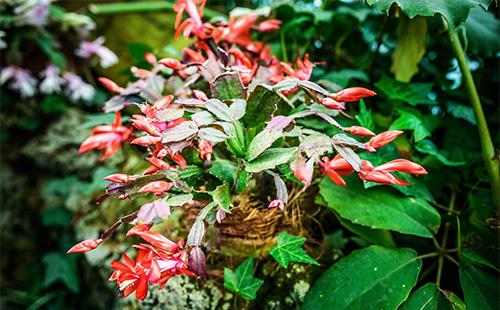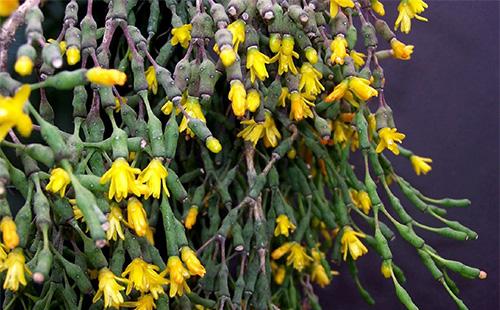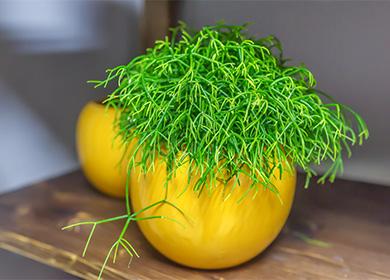The content of the article
Often in the descriptions of the flower you can find the phrase that the hator is succulent. Do not worry, this term only means that this type of plant has the ability to accumulate moisture in the tissues. Because they “live” in arid places and are forced to save water. Succulents as such do not have leaves, most often they change to thorns (in hatori, they are small and soft). Actually, cacti are typical succulents. Hatiora also belongs to cacti, although in appearance it resembles coral rather, for which it is often called the "dancing bone cactus." And it does not grow in deserts, but in tropical forests. The homeland of the haators is Brazil, and from there the flower "migrated" to South America and Africa.
Even in the description of the flower, the term “epiphyte” often flickers, which characterizes the plant as growing on other plants. But epiphytes do not parasitize at all - they use parts of other plants as a support in an attempt to get more sunlight, because tropical forests are very dense and there is little light near the earth. In addition to forests, this cactus feels pretty good on stones and rock crevices.
Species diversity
Hatiora is an evergreen perennial. The appearance of the "home" hatiora can be described as follows: a low shrub (up to 0.5 m in height, and up to 1 m in nature) with jointed stems, on the top of which flowers bloom. The inflorescences themselves resemble a bell in shape. The length and diameter of the segments of the stem vary depending on the species, the color and size of the flowers, too. In the table you can get acquainted with the characteristics of various types of haators.
Table - Characteristics of the types of hatioras
| View name | Appearance of stem segments | The appearance of inflorescences |
|---|---|---|
| Germina (Hatiora herminiae) | - Length 2-5 cm; - diameter of about 0.5 cm; - the shape is cylindrical; - color varies from dark green to gray-green; - 1-2 bristles are located on the sides | - Color raspberry; - diameter of about 2.5 cm; - one inflorescence on the top of the stem |
| Gartner (Hatiora gaertneri) | - Length is 6-7 cm; - width up to 2-2.5 cm; - the shape is elongated, elliptical; - pronounced notches along the edges; - the color is dark green, the edges may have a reddish tint | - The color is often red (may be pink or raspberry); - diameter up to 6 cm; - consists of many narrow long petals; - one inflorescence on the top of the stem |
| Pink (Hatiora rosea) | - Length 2-2.5 cm; - width 1 cm; - the shape is pin-shaped, elliptical, flat; - color is dark green; - ribbed edges | - Color from light pink to deep pink; - diameter 3-4 cm; - one inflorescence on the top of the stem |
| Salt-bearing (Hatiora salicornioides), it is also solyanka-shaped, salt-shaped, salicorniform | - Length is up to 5 cm; - diameter up to 0.7 cm; - the shape is pin-shaped; - color is dark green; | - Color more often yellow (may be red); - diameter 1 cm; - length up to 2 cm; - one inflorescence on the top of the stem |
There is also a very unusual type of hatiora - Five-winged (Hatiora pentaptera). Her stems are short, and the segments are ribbed, similar to the intersection of four to five different planes. And the inflorescences of the five-winged hatiora are not located at the top of the stem, but directly on it, at the junction of segments of the stem. The flowers themselves are small and white.
Hatior Care: Things to Consider
In nature, the hator grows in "Spartan" conditions, therefore in the city apartment does not require increased attention. As a typical succulent, the hator does not require frequent and plentiful watering, but as a tropical “resident” - he easily tolerates daily temperature drops. But, knowing how to care for the hatiora during flowering and at rest, you can achieve faster growth of the plant and more buds.
Where to place the pot
Surprisingly for the tropical inhabitant, the hator cannot stand direct sunlight. But scattered light requires a lot. With insufficient lighting, the flower stops growing and cannot bloom. Therefore, choose a sufficiently well-lit, but at the same time, a place closed to direct rays from the pot. Best option: windowsill on the west or east side of the house. In the warm season, a shaded corner on the balcony is also suitable. But on the southern windows of the hator can even get sunburns and then the plant will begin to turn yellow and wither.
How to water and spray
All cacti can survive a waterless period for a long time, but then they have to extremely save moisture. To do this, the plant discards a certain number of segments, and the remaining ones are noticeably wrinkled. In addition, the hathior stops growing and does not plant buds. The hator grows and blooms profusely only with sufficient and regular “drinking”.
In the active phase, and it falls in the warm season, the hator should be watered often, but not abundantly. Do not allow the soil to dry out - it should always be slightly moist. With an excess of moisture, the roots begin to rot, the plant withers and discards part of the segments. To avoid this, be sure to drain the liquid from the pan 30 minutes after watering. Hatiore tap water will not work - it is advisable to pour it with warm, boiled water. Or you can just let the tap water settle or clean it with any household filter.
In the dormant period (approximately from the end of September to December), you need to water the plant once a month. And after rest - more often, but not plentifully. Closer to the spring, the hator releases buds and approximately in April begins to bloom and, accordingly, enters the active period. Then you need to water, not allowing the soil to dry out.
Temperature mode
In summer, the most favorable conditions for the hator - when the daytime temperature fluctuates in the range of 20-27 ° C, and at night decreases by 6-8 ° C. Another plant loves fresh air, so in the warm season it is better to put the hatoira on the balcony or place it on the street, in the shade of the trees. If the pot is on the windowsill - often ventilate the room.
In winter, the hator is resting. During this period, you need to move the flowerpot to a cool place. The optimum temperature is 10-16 ° C. It is in coolness that the buds are laid.If the hator at dormancy does not provide the desired regime, then, most likely, spring flowering will be sparse.
When and how to feed
In nature, this cactus receives enough nutrients from the soil, because it is constantly updated naturally. Growing hatiora in a pot at home provides for periodic feeding.
In the active period, fertilizing is recommended twice a month. In the rest period, this does not need to be done at all. You can feed the hatiora with potash or phosphorus mixtures. Nitrogen fertilizers will not work - the roots will rot from them. There are even specialized purchase formulations for cacti and succulents. According to reviews of flower growers, it is better to dilute the composition twice the recommended dose, so there is no risk of overfeeding the plant.
How to transplant
The most rapid growth occurs in the first three years of the plant's life. During this period of time, you need to transplant the cactus annually, otherwise the hator will become crowded and it will cease to bloom. Starting from three years, growth rates slow down and now you can transplant less often - once every two years. Massive mature plants do not require a change of "home" more than once every five years. Do it in the spring, as soon as the flowering period ends. It’s easy to transplant the hator. Use the instructions in five steps.
- Prepare the soil mixture. The composition is: coarse sand, sheet land, peat and turf land - in equal proportions. Hatiora loves loose, oxygenated soil, so it will be useful to mix part of the charcoal into the ground.
- Pick up a pot. Hator's root system is superficial, so there is no point in a deep pot. It is better to choose a low and wide capacity. Ideal - when there is a 1-2 cm space from the roots to the walls of the pot.
- Don't forget about drainage. Be sure to lay a drain at the bottom of the pot, this will prevent root decay.
- Clean the roots. From the roots you need to remove the old earth.
- Tamp. Pour a layer of soil on the drainage, set up a plant and fill it with a second layer of earth. Top soil needs to be tamped a bit to provide the bush with greater stability. It is also recommended to tie up the stems.
Plant propagation
The easiest and fastest way to breed hatiora is vegetative. That is, cuttings. The best time for this is spring, immediately after flowering. It is necessary to “unscrew” (not cut off) a stalk consisting of at least three segments from the parent plant. And then you can apply one of the following methods.
Rooting in the water ...
The freshly broken portion of the stem is placed in a glass of clean, warm water. Soon, the plant will start the roots. And when their length reaches 2 cm - you can plant the sprout in a low pot with soil. The ground should be moist but not wet. After the soil has dried, you can water the plant, but not from above, but through a pallet.
... or immediately in the ground
This method is close to how hatiora propagation occurs in nature. But here there are two options for the preparation of cuttings.
- Sprinkle the bottom edge with ash. And forget about him for a couple of days. Then the bottom is sprinkled with a composition for the rapid growth of roots of the “Kornevin” type and planted in moist soil. Further care is reduced to periodic moistening of the earth.
- The handle is not processed. And left to dry for a week on their own. During this time, the segments should wrinkle a little. Then the cuttings are simply “stuck” in a pot with moist soil. When the shoot starts roots, the plant is replenished with moisture and the segments begin to straighten. This is a sure sign that the hatoira has taken root.

Health issues
Like any other "home" plant, the hator can get sick. Misfortunes can be associated with improper care, infectious damage, and “invasion” of insects. Next, we analyze each case in more detail.
Disease
Hatorial diseases can be bacterial or fungal in nature. Here it is important not to make a mistake with the “diagnosis”. The table discusses the causes, symptoms and methods of treating plants from various diseases.
Table - Hatoria Disease
| Disease | Cause | Symptoms | Treatment |
|---|---|---|---|
| Bacterial infection | - Excessive watering | - Segments become soft; - sticky, slippery spots appear (may be light or brown) | - Remove the affected areas; - with a large area of damage, root a healthy stalk |
| Phytophthora | - excess moisture; - soil contaminated with fungus | - Hatiora wilts (the soil is not dry at the same time); - brown-purple spots appear on the stems and at the roots (blacken with time) | - Break off the diseased stem; - sprinkle the "wound" with charcoal; - use preparations-fungicides: “Previkur”, “Fitosporin-M”, “Fundazol” |
| Fusarium | - The fungus penetrates through mechanical damage to the stem; - excessively plentiful watering; - non-compliance with the temperature regime | - Root rot; - the stems become thinner and yellow; - the plant withers; - white plaque may be present | - Apply the drugs: Previkur, Fundazol, Vitaros, Betalom and the like |
Pests
Like other "inhabitants" of the windowsill, pests can "attack" the haator. And this is most often: a spider mite, whitefly, scale shield, mealybug. The table shows how to recognize and how to get rid of parasites.
Table - Hatoria Pests
| Pest | Symptoms | Treatment |
|---|---|---|
| Spider mite | - The plant weakens; - Subtle cobwebs between the stems are noticeable; - distinguishable small white dots on segments or inflorescences; - dry, discolored areas appear on the stems | - Apply acaricidal and insecticaricidal formulations: Apollo, Agravertin, Floromayt, Fitoverm, Akarin, Borneo, etc .; - run into the pot predatory ticks: phytoseyulyusov or amblyseyusov |
| Fusarium | - The fungus penetrates through mechanical damage to the stem; - excessively plentiful watering; - non-compliance with the temperature regime | - Root rot; - the stems become thinner and yellow; - the plant withers; - white plaque may be present |
| Whitefly | - Sticky drops appear on the stems (pad); - white insects up to 3 mm in size fly around the plant; - dark spots appear; - the plant withers and sheds segments | - Apply insecticidal compositions: Actellik, Biotlin, Vertimek, Mospilan, Komandor, Pegasus, Oberon, etc .; - run into the pot predatory ticks: phytoseyulyusov or amblyseyusov |
| Shield | - The stems turn yellow; - Hathior resets segments; - small “growths” or “plaques” are visible on the stems; - sticky drops appear (pad) | - Apply insecticidal compositions: Fitoverm, Aktara, Actellik, Metaphos, Mospilan, Confidor, Agravertin, etc. |
| Mealybug | - White worms up to 6 mm in size are visible on the plant, as if covered with white wax; - egg laying is like a piece of cotton; - insect secretions resemble grains of sugar; - the plant withers and discards segments |
If you find parasites on your hator, the first thing to do is immediately isolate the flower from the "neighbors". So you reduce the risk of infection of other plants.Then you need to rinse the cactus under running water and treat it with a soapy solution. Scaffolds and mealybugs need to be "removed" from the stems with your hands, while the scabbard will have to be pinched with a thin sharp object.
The use of chemicals is justified at the initial stage of infection. If most of the flower is affected, then, unfortunately, it can no longer be saved. It is better to destroy the cactus with the earth and the pot.
Other problems
Sometimes the symptoms of a fungal infection or parasites are not visible, and the hathior still looks weakened and "sick." Here are four more atypical conditions and tips for resolving them.
- Hatiora is not blooming. Or blooms, but very modest. This happens if the plant was not allowed to "rest", that is, they did not observe the temperature regime during the rest period. The flower may not have enough nutrition, then you need to start fertilizing according to the schedule. Also, the reason is insufficient watering, that is, periodic drying of the soil was allowed (in the active phase, the top layer of the soil should always be slightly moist). Or maybe the hator is close and you need to transplant it into a more spacious pot.
- Cactus dumps inflorescences and segments. There may also be several reasons: non-compliance with irrigation rules, violation of the temperature regime, drafts. Care depends on the phase in which the plant is located, and it needs to be adjusted.
- Stem segments shrink. Cactus is not enough moisture. Need to increase watering. If the soil is moist with shriveled segments, it means that the temperature regime is violated or a draft is blowing on the plant.
- The stems turn yellow. If, at the same time, no symptoms of a flower’s infection or pests are found, then too much watering is most likely to blame.

Superstition and Signs
Do you believe in all kinds of folk signs and superstitions? It turns out that human habits were not spared by the haator too. And here are some of them.
- Razvitnitsa. Hatiora “splits” the family, brings controversy and contention into the house.
- Hater. Hatiora “survives” men, drives them into depression, leads to alcohol abuse.
- Toxic and dangerous. Some varieties of Hatori are poisonous and dangerous for children and pets.
Whatever it was, and knowing how to care for the hator and observing these rules, you can grow a tropical garden in a city apartment. And as a reward, he will delight the eye with rapid bloom in the most dull season, when the rest of the flowers are still in hibernation.

